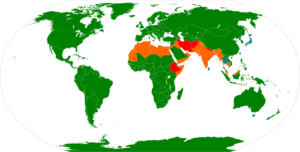Discrepancies between the Julian calendar and the length of a year led to the development and adoption of the Gregorian calendar. The Julian calendar is based on 365.25 days in a year. As such it adds an extra ‘leap’ day every four years. Unfortunately, the year is slightly shorter at approximately 365.2422 days. The difference is small, but over many years it adds up and the observed date drifts out of synch with the orbital date. Over one person’s lifetime, these small differences weren’t overly important, but for the Catholic Church, they presented a big problem.
First Easter Calculation Crisis
Easter, commemorating Jesus’s resurrection, is arguably the most sacred of Christian holidays. Jesus rose from the dead three days after the Jewish holiday of Passover. Unfortunately, the complicated relationship between the Hebrew, which includes lunar cycles, and the Julian calendar which does not, meant that Easter could fall before the equinox. To solve this problem and break away from the Hebrew calendar, the First Council of Nicaea agreed that Easter fell on the first Sunday after the first full moon occurring on or after 21 March.
Second Easter Calculation Crisis
For more than a thousand years everything worked out well enough. In the 8th century, Bede calculated that the drift had grown to more than three days. Five hundred years later, Bacon estimated that it was more than a week. In 1475, Pope Sixtus IV attempted to fix the problem, but the astronomer and mathematician Regiomontanus died before completing his work. By the late 16th century, the equinox was 10 days too early. In 1545, the Council of Trent gave the pope the authority to restore the equinox to 21 March.
Creation of the Gregorian Calendar
Resolving the problem required realigning the Julian date to the orbital date and creating a more stable calendar. Building on the work of Erasmus Reinhold and Aloysius Lilius, the Jesuit German mathematician Christopher Clavius proposed eliminating leap years for centurial years not divisible by 400. Pope Gregory XIII accepted his proposal and issued a papal bull Inter gravissimas of 24 February 1582. It declared that the day after Thursday 4 October 1582 would be Friday 15 October 1582 and the first day of the Gregorian calendar.
Staggered Adoption
While Pope Gregory’s bull had no legal authority outside the Papal States or the church, most Catholic countries quickly adopted the Gregorian calendar. Unsurprisingly, Protestant and Orthodox countries initially resisted the papal directive. Countries that waited until the 18th century had to drop eleven days to align themselves. Sweden attempted a phased approach of dropping every leap day between 1700 and 1740. It was a confusing disaster and in 1712 Sweden reverted to the Julian calendar by adding 30 February 1712. They eventually converted in 1753. When Russia, which didn’t convert until 1918, acquired Finland from Sweden in 1809, the Finns didn’t revert, but they had to maintain Julian and Gregorian dates on official documents.
What About the US?
Queen Elizabeth’s plan to create a royal commission to adopt calendar forms never materialized. As a result, Great Britain and her colonies didn’t convert until the mid-18th century. By then 11 days were needed and Wednesday 2 September 1752 became Thursday 14 September 1752. Because Spain and France had adopted the reforms earlier, this put most of North America on the Gregorian calendar. The exception was Alaska, which belonged to Russia and remained on the Julian calendar until it was purchased by the US. Alaska skipped 12 days with Saturday 7 October 1867 becoming Friday 18 October 1867.
Today’s Calendar World
The vast majority of countries use the Gregorian calendar for all civil activities. Only four countries haven’t adopted the Gregorian calendar. Iran and Afghanistan use the Solar Hijri calendar. Ethiopia maintains the Ethiopian calendar. The fourth country, Nepal, uses the Vikram Samvat and the Nepal Sambat. Some countries, e.g., Japan, use a modified version of the Gregorian calendar, while others use a different calendar alongside the Gregorian, e.g., the Indian national calendar.
That brings us to our featured map courtesy of Nederlandse Leeuw via Wikimedia Commons.
As always thanks for reading.
Armen
Note to pay the bills: My Warders series is filled with intrigue, magic, and adventure in a high fantasy world that’s appropriate for readers of all ages. Why not take a look? You can find a summary of the six book series here or find links to purchase books here.
As an aside please consider signing up for my FREE author newsletter. It will contain opportunities to preview new books, announcements, and contests related to my novels. It will not overwhelm your inbox – I’m thinking once a month or less depending on news.
If you have subscribed, but haven’t received a newsletter, please check your spam folder. Moving the newsletter to your inbox should fix the issue.




Very well explained. Thanks.
I’m glad you found it helpful.